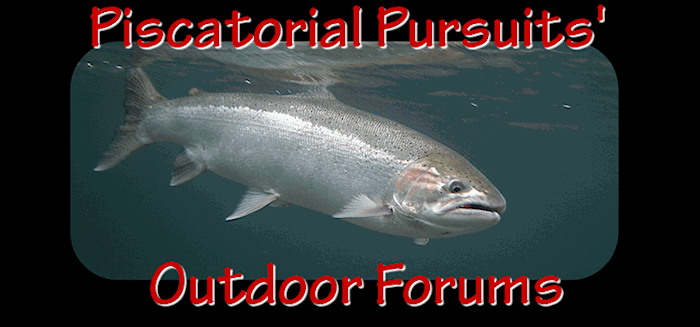#98859 - 11/04/00 08:08 PM
 Non political FYI
Non political FYI
|

Juvenille at Sea
Registered: 06/10/00
Posts: 187
Loc: port angeles wa.
|
Ran into this article on the need for increased escapement its probably not needed on election years what with all the extra BS going around but it is good info for those who want more out of life than your egg recipe http://www.noaanews.noaa.gov/stories/s518.htm
|
|
Top
|
|
|
|
#98860 - 11/06/00 10:37 PM
 Re: Non political FYI
Re: Non political FYI
|

Juvenille at Sea
Registered: 03/08/99
Posts: 127
Loc: Puyallup WA
|
PP 7 and 8 seem to imply that global warming would be good for salmon runs???? I generally think NOAA does good work but this finding would stand in stark contrast to the beliefs of many in the environmental movement including those at NOAA. My guess is that no one really knows either the cause or effect of global temperature trends with any level of confidence. Good article though. I would like to see the escapement levels increased dramatically in our state.
|
|
Top
|
|
|
|
#98861 - 11/06/00 11:06 PM
 Re: Non political FYI
Re: Non political FYI
|


Dazed and Confused

Registered: 03/05/99
Posts: 6367
Loc: Forks, WA & Soldotna, AK
|
Thanks for the link ... can't say that there's too much new in it, but good to see some more discussion of the interrelationship of the different runs ... wish our managers could get a clue on this one. An outfit named SP Cramer & Assoc. had a study on their website a year or two back talking about the optimum number of salmon spawners per mile for maximum steelhead returns ... way higher than anything this state has seen in recent years. Perhaps we can forward this to every fish bio in Olympia!
_________________________
Seen ... on a drive to Stam's house:   "You CANNOT fix stupid!"
|
|
Top
|
|
|
|
#98863 - 11/07/00 05:28 PM
 Re: Non political FYI
Re: Non political FYI
|

Juvenille at Sea
Registered: 09/30/99
Posts: 106
Loc: White Salmon, WA
|
Just because a little of something may be good doesn't mean that a whole lot would be better!
Ocean temperatures, that is.
The temperature oscillations are smaller in scale and in scope than those forecasted by global warmiing researchers. Also, they oscillate back and forth, which in itself may have some as yet unknown benefit to salmon populations. Global warming is predicted to be pretty much in one direction.
It's an interesting article. Reminds me of Frank Amatos latest editorial in STS. Frank proclaims nutrient supplementation to be the silver bullet in recovery of northwest salmon populations. The NOAA article suggests that it could help in some situations but probably wouldn't be effective in all streams. I wish the article said what the other nutrient sources were in the Bristol Bay lakes.
Amato's editorial suggests using raw nutrient additions to streams. Some kind of chemical drip feeder, I imagine. I think that this idea has promise, and the NOAA article seems to agree. My only worry would be that managers could use raw nutrient inputs as a substitute for increased escapement, rather than as a short-term aid.
|
|
Top
|
|
|
|
#98864 - 11/07/00 07:53 PM
 Re: Non political FYI
Re: Non political FYI
|

Parr
Registered: 05/31/00
Posts: 42
Loc: Federal Way
|
Silver bullet Of Nw salmon recovery? I hope not to many other people feel that way. Nutrient suplementation is something that has great promise but not for all species. The research sugests that it can dramaticly improve the survival of juvinile Coho and Steelhead, and you could probably extend that to Spring Chinook. But Summer/Fall Chinook, Pink and Chum dont generally spend significant time in the rivers you would expect the impacts to minimal.
|
|
Top
|
|
|
|
#98865 - 11/07/00 10:53 PM
 Re: Non political FYI
Re: Non political FYI
|

Juvenille at Sea
Registered: 09/30/99
Posts: 106
Loc: White Salmon, WA
|
That's a good point. If it is a workable idea it could only be applied on certain species, in certain watersheds, and (hopefully) only as a temporary measure on streams where management itself can't immediately increase escapement to adequate levels.
My biggest problem with the idea in areas where it may help is that it kind of sounds like an excuse to continue harvest business as usual. Amato's biases are obvious, considering his ragazine (which I am admitedly addicted to).
|
|
Top
|
|
|
|
#98866 - 11/10/00 11:40 AM
 Re: Non political FYI
Re: Non political FYI
|

Juvenille at Sea
Registered: 06/10/00
Posts: 187
Loc: port angeles wa.
|
Gentlemen, Thank you for the response this disscussion and similar ones are to me the very valid reason for maintaining a presence on the www re. fish.
I personally happen to beleieve that the long term ocean cycles are undisputible and can be obseved by all who are obsevant and have paid attention to the runs of fish from L.A. to Barrow.
I was fortunate to be able to live in S.E. Alaska from 1978 through 1999 and during that time witnessed the rebound of virtually all the regions anadroumous stocks. One thing that always stood out in my mind was the almost parralell decline that was taking place in OreIdaWa and California. This was puzzeling and was always magnified on the years that the Cliamitoligist refered to as El Ninio. It became pretty obvios that good fishing in Ak. had a connection to weak runs in the South. Having many friends in the biological community this subject was disscussed ad nauseam and many interesting theories were advanced. Most like my own were not published or written, you see the professionals can also engage in BS sessions and provide there own version of antecdotal information.
The common thought that seem to be present in many of these talks was that warm ocean conditions was good for northern stocks and bad for southern stocks. Not very revealing stuff but when the fish your charged with managing are the ones doing so well most of the biolical decision are easier to make re. adequate escapement.
It looks like the pendelum has swung back, and while it may be a bit premature to say a rebound is on the way in Southern stocks of fish the northern stocks are showing a slight decline.
The references to overfishing on Kodiak socckeyes go all the way back to the early days of the Russian fur trade and later to the USFWS lack of manegment and escapement. As a side note Karluk sockeyes from Kodiak were transplanted in lake Ozzette and the Quinault which is an interesting local connection to all this.
Any way things look promising and I hope everybody can keep from peeing in there pants long enough to get a little extra escapment into what I regard as severly compromised riparian habitat. I fear that the harvest oriented types will look at afew extra fish for an excuse to loosen up on regulations. Be ever vigilant in the cause of wild stock protection!
|
|
Top
|
|
|
|
#98867 - 11/10/00 03:09 PM
 Re: Non political FYI
Re: Non political FYI
|

Repeat Spawner
Registered: 11/04/99
Posts: 983
Loc: Everett, Wa
|
More proof to the Pacific Decedal Oscilltion and its effect on salmon runs. A effect that is completely out of our hands and has not been linked to global warming.
We are at a point where we NEED to get in gear because we really have a golden oppurtunity to get many of our native salmon runs on track.
[This message has been edited by RPetzold (edited 11-10-2000).]
_________________________
Ryan S. Petzold
aka
'Sparkey' and/or 'Special'
|
|
Top
|
|
|
|
#98868 - 11/10/00 07:10 PM
 Re: Non political FYI
Re: Non political FYI
|

Returning Adult
Registered: 07/28/99
Posts: 447
Loc: Seattle, WA, USA
|
Native Son,
Your observations are remarkably accurate; there is indeed a flip flop of run strength between Alaskan runs and Pac. northwest runs depending upon which part of the cycle we are in. Several climatologists and biologists published a paper showing this in the Bulletin of the American Meteorological Society in 1997 (not available on the web).
During this century, the warm cycle occurred from 1925 to 1946, followed by a cool cycle from 1947 to 1977, and a warm cycle from 1978 to 1997. We seem to have moved into another cool cycle in 97/98. The cool cycle favors Pac. NW runs with declines in Alaska. If the past is an indicator of the future, we would expect greater returns over the next 20 to 30 years.
How global warming would affect this cycle is anyones guess.
As far as artificial nutrient inputs, I agree with the post that stated that the benefits would not be as great down here. The greatest benefits would be for sockeye runs because these fish spend 1-2 years in a freshwater lake environment before migrating to sea. Nutrients, whether they be salmon carcasses or artificial inputs have a much greater affect in lakes where they can settle to the bottom and water is not flowing. This allows algae blooms and zooplankton populations to explode, characteristics of lakes, not streams. This provides juvenile sockeye with a lot more accessible prey, much more so then would be observed in a stream environment.
Not a silver bullet, but it certainly should be policy that non-diseased hatchery carcasses be returned to streams.
Finally, I am loath to say anything political, but I fear there would be a substantial incentive for a less-environmentally sensitive administration to reduce salmon recovery efforts, if indeed salmon returns begin to rebound because of more favorable ocean conditions. The tougher decisions that tend to hurt could go by the wayside--such as extending riparian buffers on streams, reducing harvest quotas, logging, agro, and development contraints within salmon watersheds, etc.
A century of evidence (even more) indicates that any increased runs would be temporary.
|
|
Top
|
|
|
|
#98869 - 11/10/00 07:45 PM
 Re: Non political FYI
Re: Non political FYI
|

Returning Adult
Registered: 03/29/99
Posts: 373
Loc: Seattle, WA USA
|
Silver Bullets, et.al.: I think the artificial enrichment was in the form of a recently developed, slow-dissolving "biscuit"
of chemicals that, dumped into the stream, would provide a long-term source of nutrients. While I can see a certain value to this sort of thing under particular circumstances, I think that the real answer lies in a change of philosophy from the Maximum Sustained Yield model that still seems to imbue our concept of fisheries management. I recently read that only an estimated three percent of historic carcass quantities are currently left in most streams. It's not difficult to see the effect that this has on mammal and bird species, but we can't look beneath the water and see the depletion of microorganisms that would feed invertebrates that would, in turn, feed trout and salmon parr and smolts. Certainly, the effect would be minimal on those species that spend little time in fresh water, that's why we still have (in some cases anyway) strong runs of chum and humpies. But, I fear, there are no silver bullets. Even with adequate numbers of carcasses in the rivers, we need good spawning habitat, not gravel beds choked with silt or washed out from floods that are the result of development and poor logging and agricultural practices; of course, if the fish wind up in a net somewhere, without having spawned, it's kind of a moot point. The ecology of a watershed is a very complex web and you can't just tweak it here and there and expect everything to be hunky-dory. I think we now have, or are at least beginning to get, good science, now all we need are political and economic interests who are willing to put that ahead of votes and profits. I wish I could be more optimistic.
_________________________
PS
|
|
Top
|
|
|
|
#98870 - 11/10/00 09:10 PM
 Re: Non political FYI
Re: Non political FYI
|

Juvenille at Sea
Registered: 09/30/99
Posts: 106
Loc: White Salmon, WA
|
PS,
I agree with your last point, but I don't believe that economic interests will ever be willing to sacrifice profits for habitat. They must be made to. That's why it was sad to see Measure 7 pass in Oregon. If this thing holds up to court challenges it will pretty much negate what regulatory progress has been made in streamside protection.
Obsessed, there is currently a large body of evidence suggesting that decaying fish, and the nutrients that are released during decay, are hugely important in stream ecosystem function in these latitudes. Regular nutrient inputs are perhaps more critical in streams than in lakes, because, as you said, stream water flows and nutrients exit the systems relatively quickly. They may not be as fully exploited as they would be in lakes but the temporary nature of nutrient availability in streams makes regular inputs absolutely necessary.
|
|
Top
|
|
|
|
#98871 - 11/14/00 09:36 AM
 Re: Non political FYI
Re: Non political FYI
|

Juvenille at Sea
Registered: 06/10/00
Posts: 187
Loc: port angeles wa.
|
Lake fertilezation projects have been used since the early 80's in SE Alaska most have been successful.
The first to embark on this program were the commercial fisherman funded Aqua culture assoc. in Ketchikan and Sitka. Most of the projects were on isolated lakes with no anadromous stocks due to high waterfalls etc.
The U.S. Forrest Service got involved in funding and The State and Fed. did several enhancement projects on depleted Sockeye systems. The runs in most of these project areas appear to have increased and in most instances not only Sockeye but Coho too.
One problem that is an off shoot of all man made projects is that the indegenous populations often get left behind and the increased harvest of the enhanced run always hurts the Native stocks. No different in Ak. than any where else, so far the managers have done a good job of allowing for escapement in this regard. But as you may or may not know the Fed has taken over the managment of Fisheries in Ak. and only time will tell how they will perform, I am nervous.
|
|
Top
|
|
|
|
|
|
1 registered (28 Gage),
1195
Guests and
9
Spiders online. |
|
Key:
Admin,
Global Mod,
Mod
|
|
11502 Members
17 Forums
72973 Topics
825669 Posts
Max Online: 3937 @ 07/19/24 03:28 AM
|
|
|
















 Previous Topic
Previous Topic Index
Index

